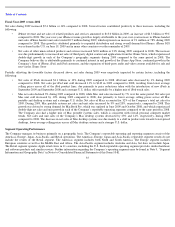Apple 2010 Annual Report Download - page 33
Download and view the complete annual report
Please find page 33 of the 2010 Apple annual report below. You can navigate through the pages in the report by either clicking on the pages listed below, or by using the keyword search tool below to find specific information within the annual report.
Table of Contents
Beginning in the third quarter of 2010 in conjunction with the announcement of iOS 4, the Company’
s ESPs for the embedded software upgrade
rights included with iPhone, iPad and iPod touch reflect the positive financial impact expected by the Company as a result of its introduction of a
mobile advertising platform for these devices and the expectation of customers regarding software that includes or supports an advertising
component. iOS 4 supports iAd, the Company’
s new mobile advertising platform, which enables applications on iPhone, iPad and iPod touch to
feature media-rich advertisements within applications.
The Company records reductions to revenue for estimated commitments related to price protection and for customer incentive programs,
including reseller and end-user rebates, and other sales programs and volume-
based incentives. For transactions involving price protection, the
Company recognizes revenue net of the estimated amount to be refunded, provided the refund amount can be reasonably and reliably estimated
and the other conditions for revenue recognition have been met. The Company’
s policy requires that, if refunds cannot be reliably estimated,
revenue is not recognized until reliable estimates can be made or the price protection lapses. For customer incentive programs, the estimated cost
of these programs is recognized at the later of the date at which the Company has sold the product or the date at which the program is offered.
The Company also records reductions to revenue for expected future product returns based on the Company’
s historical experience. Future
market conditions and product transitions may require the Company to increase customer incentive programs and incur incremental price
protection obligations that could result in additional reductions to revenue at the time such programs are offered. Additionally, certain customer
incentive programs require management to estimate the number of customers who will actually redeem the incentive. Management’
s estimates
are based on historical experience and the specific terms and conditions of particular incentive programs. If a greater than estimated proportion
of customers redeem such incentives, the Company would be required to record additional reductions to revenue, which would have a negative
impact on the Company’s results of operations.
Valuation and Impairment of Marketable Securities
The Company’s investments in available-for-
sale securities are reported at fair value. Unrealized gains and losses related to changes in the fair
value of investments are included in accumulated other comprehensive income, net of tax, as reported in the Company’
s Condensed
Consolidated Balance Sheets. Changes in the fair value of investments impact the Company’
s net income only when such investments are sold
or an other-than-
temporary impairment is recognized. Realized gains and losses on the sale of securities are determined by specific identification
of each security’s cost basis. The Company regularly reviews its investment portfolio to determine if any investment is other-than-
temporarily
impaired due to changes in credit risk or other potential valuation concerns, which would require the Company to record an impairment charge in
the period any such determination is made. In making this judgment, the Company evaluates, among other things, the duration and extent to
which the fair value of an investment is less than its cost, the financial condition of the issuer and any changes thereto, and the Company’
s intent
to sell, or whether it is more likely than not it will be required to sell, the investment before recovery of the investment’
s amortized cost basis.
The Company’s assessment on whether an investment is other-than-
temporarily impaired or not, could change in the future due to new
developments or changes in assumptions related to any particular investment.
Inventory Valuation and Inventory Purchase Commitments
The Company must order components for its products and build inventory in advance of product shipments. The Company records a write-
down
for inventories of components and products, including third-
party products held for resale, which have become obsolete or are in excess of
anticipated demand or net realizable value. The Company performs a detailed review of inventory each fiscal quarter that considers multiple
factors including demand forecasts, product life cycle status, product development plans, current sales levels, and component cost trends. The
industries in which the Company competes are subject to a rapid and unpredictable pace of product and component obsolescence and demand
changes. If future demand or market conditions for the Company’
s products are less favorable than forecasted or if unforeseen technological
changes negatively impact the utility of component inventory, the Company may be required to record additional write-
downs, which would
negatively affect its results of operations in the period when the write-downs were recorded.
30
























